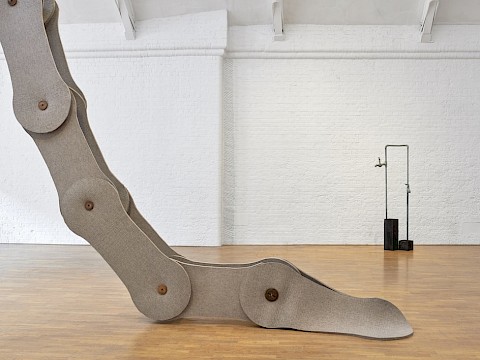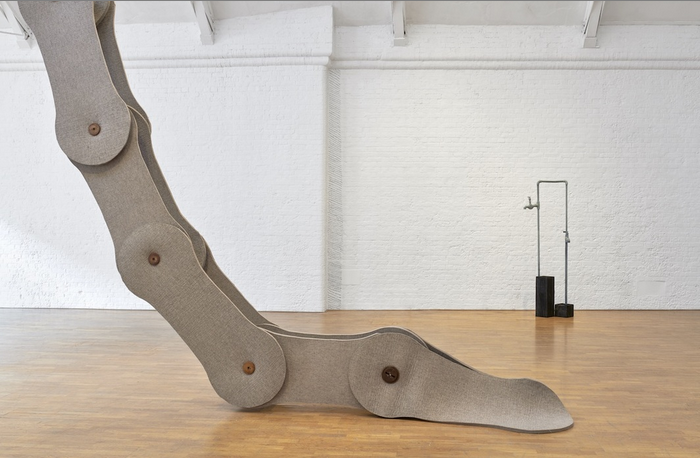03 March 2020
Interview with Johanna Unzueta
Johanna Unzueta on layering history, labor, and self in her art
Emily LaBarge, Artforum, March 2020


Image description:
Johanna Unzueta, Related to Myself, 2019–20, felt, thread, recycled wooden spools, burnt wood, dimensions variable
Johanna Unzueta’s speech, lilting and melodic, is peppered with one of art’s most taboo words: beautiful. And yet it suits to a tee her capacious and interdisciplinary practice, one that transmutes—through delicate material sleights—the ordinary into the surprising, and by turns dazzling. A huge chain, made from thick cuts of gray felt, unfurls from the ceiling, each oversized link fragile yet tough, warped just slightly at the edges; a set of pale ochre and blue-striped uniforms hang mutely on a clothing rack; wall drawings in charcoal and bronze dip in and out of corners, ladder up and down walls, glinting in the light. Craft, intuition, and collective histories and methods are deeply embedded in the deceptively modest, pared down language of Unzueta’s art. In the midst of shows in Munich, Oxford, and Edinburgh, she discusses her work.
AS AN ARTIST, you are drawn to certain themes. For me they have always been the same—labor and history. At the moment, these issues are incredibly salient: During the past decade, we have become more conscious about resources, and how they relate to artistic production. I’m from Chile, where I studied art, and I was always interested in how universities provide a bubble that protects your work while simultaneously giving it the status of “art.” I felt challenged to make work outside of the institution, to be in contact with people who didn’t have any relation to art museums, because this was the situation in which I grew up—during the dictatorship, with little exposure to culture. I learned to be conscious of the environment and of how to produce efficiently, which also related to the economic situation: I had to carry my own art everywhere, so I worked with cardboard and felt—things that could be easily transported to and assembled in public space.
The materials I use are impermanent, vulnerable to change. The oil pastel and charcoal of the murals, or the tinted papers of the drawings—these alter over time. This transience is about how we exist, our expectations of permanence and longevity. We change every day, nothing stays the same. I like my work to reflect this. I don’t expect it to have a long life. I expect it to live as long as you or I, maybe, or a flower or a tree. I use my body to measure my work, using my physical perceptions within each different context. It’s a beautiful, visceral experience, because you learn more about yourself: We are not symmetrical! In the large chain at Modern Art Oxford, each link is the size of my body: I like to say, you have sixteen Johannas there.
I have a strong affinity for textiles, which are a second skin for all of us. The question of how things are made and where they come from is important. My mother taught me to sew and to make my own clothes using organic dyes—a process that encouraged me to experiment. I’ve been lucky to work with a group of Mapuche women in the south of Chile and in Guatemala with people who have knowledge about natural pigments. Every place I visit, I try to learn about what has been produced there, its industry—from a factory in Munich to an artisan button-maker in Mexico City. I love to see the art of people producing their own costumes, which is now difficult for so many given limited access to materials.
We have so much power on one side of the globe, and we are ignorant of the enormous impact of our behavior on other cultures. For a long time, I didn’t talk about the work I did with communities, because that can become something artists take advantage of, or might seem to, politically. But it’s important to record the real impact of post-industrialization and globalization. Even recycling textiles is political: First class waste goes to Japan and East Asia, second class to Europe and the US, third class to South America. The fabric I used to make the uniforms on display at MOA is from a factory in Guatemala that upcycles denim. For me, this was the only fabric that piece could be made from, to hold the invisibility of labor networks so succinctly in an object. Some of the objects I make, like the felt pipes and taps, are also meant to amuse: Here I am, don’t take me for granted!
Six years ago, I started making drawings, a process that came out of pain: The repetitive work I was doing gave me carpal tunnel in both hands. One day, I drew a circle that was me and a bigger circle that was society, like a mathematical subset. I saw that where they overlap is what we create. Drawing changed my life: the way I see, the way I speak. I don’t measure or make sketches, it’s an intuitive process—the color of the paper and how the shapes, which are based on embroidery hoops, will emerge. The final images are composites of shapes and forms natural and imagined, everything that overlaps inside of me. That’s my philosophy: collective ideas and beliefs, trusting the people around you. It is also about joy, the privilege of doing something every day that you are happy to do, even if it’s only momentary—because art is like this. One day you’re here and the next, you don’t know.
— As told to Emily LaBarge